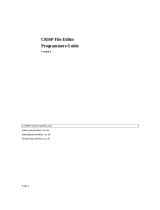
Dynamic C User’s Manual digi.com 6
root................................................................213
scofunc..........................................................213
segchain ........................................................214
shared............................................................214
short ..............................................................214
size................................................................215
signed............................................................215
sizeof ............................................................215
speed.............................................................215
static..............................................................216
struct .............................................................216
switch............................................................217
typedef ..........................................................217
union.............................................................218
unsigned........................................................218
useix..............................................................218
waitfor ..........................................................219
waitfordone
(wfd) ........................................................219
while .............................................................220
xdata .............................................................220
xmem ............................................................221
void...............................................................221
volatile ..........................................................222
xstring...........................................................222
yield ..............................................................222
14.1 Compiler Directives .............................223
#asm..............................................................223
#class ............................................................223
#debug
#nodebug .................................................224
#define ..........................................................224
#endasm........................................................224
#error ............................................................224
#fatal.............................................................225
#funcchain ....................................................225
#GLOBAL_INIT..........................................225
#if
#elif
#else
#endif .......................................................226
#ifdef ............................................................226
#ifndef ..........................................................227
#include ........................................................227
#interleave
#nointerleave ...........................................227
#makechain...................................................228
#memmap .....................................................228
#pragma ........................................................228
#undef...........................................................228
#use...............................................................229
#useix
#nouseix...................................................229
#warns ..........................................................229
#warnt...........................................................229
#ximport .......................................................230
#zimport........................................................230
15. Operators
15.1 Arithmetic Operators
...........................232
+....................................................................232
– ....................................................................232
*.................................................................... 233
/..................................................................... 233
++ ................................................................. 234
––.................................................................. 234
% .................................................................. 234
15.2 Assignment Operators ......................... 235
= ................................................................... 235
+= ................................................................. 235
-= .................................................................. 235
*= ................................................................. 235
/= .................................................................. 235
%= ................................................................ 235
<<=............................................................... 235
>>=............................................................... 235
&= ................................................................ 236
^=.................................................................. 236
|=................................................................... 236
15.3 Bitwise Operators................................. 236
<< ................................................................. 236
>> ................................................................. 236
&................................................................... 237
^.................................................................... 237
|..................................................................... 237
~.................................................................... 237
15.4 Relational Operators ............................ 238
< ................................................................... 238
<= ................................................................. 238
> ................................................................... 238
>= ................................................................. 238
15.5 Equality Operators ............................... 239
== ................................................................. 239
!= .................................................................. 239
15.6 Logical Operators................................. 240
&&................................................................ 240
|| .................................................................... 240
! .................................................................... 240
15.7 Postfix Expressions.............................. 240
( ) .................................................................. 240
[ ] .................................................................. 240
. (dot)............................................................ 241
-> .................................................................. 241
15.8 Reference/Dereference Operators...... 242
&................................................................... 242
*.................................................................... 242
15.9 Conditional Operators ......................... 243
? :.................................................................. 243
15.10 Other Operators .................................. 244
(type) ............................................................ 244
sizeof ............................................................ 244
,..................................................................... 245
16. Graphical User Interface
16.1 The GUI Environment
......................... 246
16.1.1 Editing ........................................... 246




















